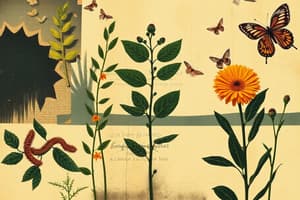Podcast
Questions and Answers
What are autotrophs?
What are autotrophs?
- Organisms that make their own food (correct)
- Organisms that consume other organisms for energy
- Organisms that cannot photosynthesize
- All of the above
What do photoautotrophs do?
What do photoautotrophs do?
Convert light from the sun into chemical energy
What is photosynthesis?
What is photosynthesis?
The process by which plants use light energy to make sugars and organic molecules
What are heterotrophs?
What are heterotrophs?
What is chlorophyll?
What is chlorophyll?
What is mesophyll?
What is mesophyll?
What are stomata?
What are stomata?
What is stroma in a chloroplast?
What is stroma in a chloroplast?
What are thylakoids?
What are thylakoids?
What is a granum?
What is a granum?
What are light reactions?
What are light reactions?
What is NADP+?
What is NADP+?
What is the Calvin cycle?
What is the Calvin cycle?
What is carbon fixation?
What is carbon fixation?
What is the electromagnetic spectrum?
What is the electromagnetic spectrum?
What is wavelength?
What is wavelength?
What is a photon?
What is a photon?
What is a photosystem?
What is a photosystem?
What is photophosphorylation?
What is photophosphorylation?
What is chlorophyll a?
What is chlorophyll a?
What is a C3 plant?
What is a C3 plant?
What is photorespiration?
What is photorespiration?
What is a C4 plant?
What is a C4 plant?
What is a CAM plant?
What is a CAM plant?
Flashcards are hidden until you start studying
Study Notes
Autotrophs and Heterotrophs
- Autotrophs produce their own food through processes like photosynthesis, allowing them to thrive without consuming other organisms.
- Heterotrophs cannot synthesize their own food and rely on consuming other organisms or organic materials for energy.
Photosynthesis Process
- Photosynthesis is a biochemical process used by plants, autotrophic protists, and some bacteria to convert light energy, carbon dioxide, and water into sugars and organic compounds.
Key Components of Photosynthesis
- Chlorophyll: The green pigment in chloroplasts responsible for capturing light energy for photosynthesis.
- Mesophyll: The leaf tissue where most photosynthesis occurs, containing a high density of chloroplasts.
- Stomata: Pores on leaf surfaces that facilitate gas exchange; they allow CO2 in and permit water and O2 out.
- Stroma: The fluid within chloroplasts where the Calvin cycle occurs, synthesizing glucose from CO2 and energy.
Thylakoids and Granum
- Thylakoids: Membranous sacs in chloroplasts where light reactions occur; contain chlorophyll.
- Granum: A stack of thylakoids, crucial for capturing light energy during the light reactions.
Stages of Photosynthesis
- Light Reactions: Initial stage that converts solar energy into chemical energy (ATP and NADPH) without producing sugar.
- Calvin Cycle: The second stage that uses ATP and NADPH from light reactions to synthesize glucose in the stroma.
Carbon Fixation
- The process of incorporating atmospheric CO2 into organic compounds, crucial for forming energy-rich sugars in plants.
Light and Energy
- Electromagnetic Spectrum: Range of all types of radiation, including the wavelengths visible to plants for photosynthesis.
- Wavelength: Distance between wave crests; shorter wavelengths correspond to more energetic photons.
- Photon: Basic unit of light energy; energy level is inversely related to wavelength.
Photosystems and Energy Production
- Photosystem: Complex in thylakoid membranes that captures light energy for conversion during photosynthesis.
- Photophosphorylation: ATP production linked to light absorption during the light reactions.
Specific Plant Types
- C3 Plants: Use the Calvin cycle for initial CO2 incorporation, producing three-carbon compounds.
- C4 Plants: Incorporate CO2 into four-carbon compounds before the Calvin cycle to enhance efficiency.
- CAM Plants: Adaptation for arid conditions; they fix CO2 at night to minimize water loss during the day.
Photorespiration
- A metabolic pathway that occurs under hot, dry conditions when O2 levels rise and negatively impacts photosynthesis, producing no sugar or ATP.
Studying That Suits You
Use AI to generate personalized quizzes and flashcards to suit your learning preferences.




